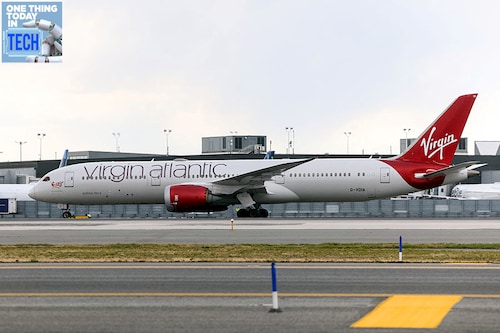Flight100, Virgin Atlantic's green trip, spotlights aviation's carbon emissions
Less than 0.1 percent of jet fuel today is based on non-fossil based greener alternatives, highlighting the need for stepping up efforts


The first trans-Atlantic flight using 100 percent sustainable aviation fuel was made between London and New York yesterday by Britain’s Virgin Atlantic, bringing the industry another small step closer to sustainable aviation.
Test flight VIR100, which did not carry paying passengers, took off from London’s Heathrow Airport at 11:49 am UK time (6:49 am ET and 5:19 pm in India) and landed at New York’s JFK airport at 2:05 pm ET, CNBC reported, citing Flightradar24.
The flight, which the airline named Flight100, demonstrated that sustainable aviation fuel (SAF) was a safe drop-in replacement for the current fossil-fuel based jet fuel, compatible with today’s engines, airframes and fuel infrastructure, Virgin Atlantic said in a press release yesterday.
“Flight100 proves that sustainable aviation fuel can be used as a safe, drop-in replacement for fossil-derived jet fuel," Shai Weiss, CEO of Virgin Atlantic, said in the press release.
SAF is made from non-fossil based raw materials, including plant and animal waste, and synthetic chemicals via industrial processes. That it can be a drop-in alternative means that it can be used with the existing commercial aircraft without any costly modifications to their engines, ground infrastructure and so on.
Virgin’s Flight100 was made by a Boeing 787 wide-body aircraft, flying on Rolls Royce Trent 1000 engines, according to the press release.
“Rolls-Royce has recently completed compatibility testing of 100 percent SAF on all us in-production civil aero engine types and this is further proof that there are no engine technology barriers to the use of 100 percent SAF," Simon Burr, group director of engineering, technology and safety at Rolls-Royce said in the press release.
SAF also produces emissions, but overall carbon emissions from them are considered to be lower than emissions from fossil fuels.
In 2021, a group of 60 companies from the airline, transport and cargo industries promised to ensure that 10 percent of all the jet fuel they used was SAF. And last year, the aviation industry set itself the target of reaching net zero status by 2050.
SAF is made from waste products, and delivers CO2 lifecycle emissions savings of up to 70 percent, whilst performing like the traditional jet fuel it replaces, according to Virgin’s press release.
Today, SAF represents less than 0.1 percent of global jet fuel volumes and fuel standards allow for only 50 percent SAF blend in commercial jet engines. That said, as things stand today, the aviation sector views SAF as a more viable alternative to electric motors and hydrogen burning turbines, which it sees as being “decades away" from commercialization, according to the Virgin press release.
CNBC notes that other airlines have used SAF on commercial flights, but on shorter trips and in the up-to-50 percent blends with regular fuel, which was the previous regulatory limit. Tuesday’s Virgin Atlantic flight was approved by the UK’s Civil Aviation Authority earlier this month.
Flight100 will also assess how its use affects the flight’s non-carbon emissions with the support of consortium partners ICF, Rocky Mountain Institute (RMI), Imperial College London and University of Sheffield, Virgin said in its press release.
The SAF used on Flight100 is a dual blend comprising 88 percent hydro-processed esters and fatty acids (HEFA), supplied by AirBP, the aviation supplier division of BP, and 12 percent synthetic aromatic kerosene (SAK), supplied by Virent, a subsidiary of US-based Marathon Petroleum Corporation.
The HEFA is made from waste fats while the SAK is made from plant sugars, with the remainder of plant proteins, oil and fibres continuing into the food chain. The kerosene is needed in 100 percent SAF blends to give the fuel the required aromatics for engine function, according to the press release.
In 2022, aviation accounted for two percent of global energy-related CO2 emissions, having grown faster in recent decades than rail, road or shipping, the International Energy Agency notes in its assessment of the industry.
As international travel demand recovered following the Covid-19 pandemic, aviation emissions in 2022 reached almost 800 million tonnes of CO2, about 80 percent of the pre-pandemic level, according to the IEA.
Many technical measures related to low-emission fuels, improvements in airframes and engines, operational optimisation and demand-restraint solutions are needed to curb growth in emissions and ultimately reduce them this decade in order to get on track with the net zero emissions by 2050 scenario, the IEA notes, which currently views the aviation sector as being not on track to meet this target.
Earlier this year, the Royal Society, the UK’s national academy of sciences, published a report assessing a variety of alternative fuels, including biofuels, and found that availability and accessibility are among the top problems, Mongabay, a US-based non-profit conservation and environmental science news platform, notes in a July report.
Very few of today’s biofuels actually meet our needs for drastic reductions in emissions, according to the Royal Society’s findings, Mongabay reports. Biofuels made from oil crops, with their current processes, don’t qualify.
“There’s simply not enough SAF and it’s clear that in order to reach production at scale, we need to see significantly more investment," Weiss said in the release. “This will only happen when regulatory certainty and price support mechanisms, backed by government, are in place," he added.
That basically means the industry expects more public money to be spent on the development of this fuel.
First Published: Nov 29, 2023, 13:33
Subscribe Now